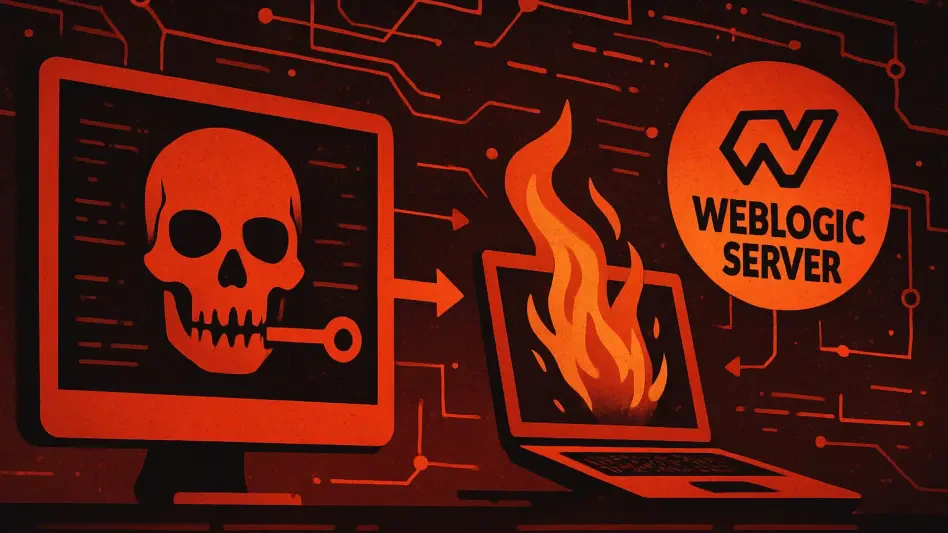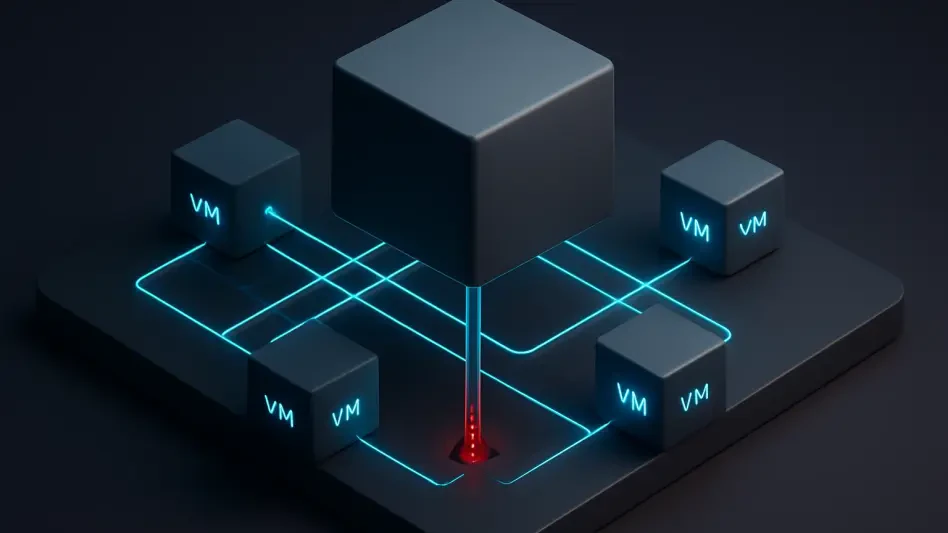In a chilling display of cybercriminal ingenuity, the Clop ransomware gang executed a sophisticated attack in August 2023, targeting a previously unknown vulnerability in Oracle WebLogic Server. Labeled as CVE-2023-21839, this zero-day flaw remained under the radar of security researchers and media until significant damage had already been inflicted. Unlike traditional ransomware attacks that lock systems and demand payment for decryption, Clop adopted a stealthier approach, focusing on pure data theft without deploying malware or encryption. This incident not only exposed critical weaknesses in legacy systems but also highlighted a disturbing evolution in ransomware tactics. As enterprises worldwide grapple with the fallout, understanding the mechanics of this exploit and the strategic shifts it represents becomes imperative for bolstering defenses against similar threats.
1. Uncovering the Hidden Threat of CVE-2023-21839
The discovery of CVE-2023-21839 in Oracle WebLogic Server sent shockwaves through the cybersecurity community, as it revealed how even well-established systems can harbor undetected flaws. This vulnerability, exploited by the Clop ransomware gang, allowed attackers to bypass authentication entirely, gaining SYSTEM-level access through the T3 protocol used for communication between WebLogic nodes. What makes this flaw particularly alarming is its ability to grant remote control without any user interaction, such as phishing attempts or end-user clicks. Large enterprises, many of which rely on WebLogic as a legacy platform, were caught off guard, as the vulnerability had not been publicized until after significant exploitation had occurred. This incident underscores the dangers of zero-day vulnerabilities, which remain unknown to vendors and defenders until attackers strike, leaving little time for proactive measures.
Further examination of CVE-2023-21839 reveals the precision with which Clop operated, avoiding the noise typically associated with ransomware attacks. Instead of encrypting data or disrupting operations, the gang focused on surgical data theft, extracting sensitive information without triggering immediate alerts. This approach marks a paradigm shift in cybercrime, where the emphasis is no longer on causing visible harm but on leveraging stolen data for extortion. The T3 protocol, often overlooked by standard security tools, provided an ideal entry point for attackers to infiltrate systems unnoticed. As a result, organizations using WebLogic Server faced not just a technical breach but a strategic challenge in rethinking how to defend against such covert operations. The lack of prior awareness about this flaw amplifies the urgency for better vulnerability detection mechanisms.
2. Clop’s Stealthy Execution Tactics
Clop’s approach to exploiting CVE-2023-21839 was marked by a deliberate avoidance of traditional ransomware payloads, opting instead for direct, unauthenticated access to vulnerable WebLogic instances. By targeting exposed systems, the gang could infiltrate networks without raising immediate suspicion, a stark contrast to the loud, disruptive nature of encryption-based attacks. Their methodology involved sending crafted T3 packets that the server accepted as legitimate, granting attackers high-level privileges without requiring credentials. This silent infiltration allowed Clop to operate under the radar, focusing on reconnaissance and data harvesting rather than locking systems. Such tactics reveal a calculated shift toward maximizing impact through stealth rather than overt destruction.
Once inside, Clop deployed lightweight tools to map internal networks and extract valuable data, including contracts, HR files, and financial records. After gathering what they needed, the attackers exited quietly, leaving no immediate trace of their presence, only to return later with ransom demands threatening public data leaks. This modern extortion model prioritizes the value of stolen information over operational downtime, exploiting the fear of regulatory penalties and reputational damage. The gang’s ability to execute these steps without triggering conventional security alerts highlights the limitations of existing defense mechanisms against zero-day exploits. Organizations must now contend with threats that prioritize invisibility, making timely detection and response more challenging than ever.
3. Why WebLogic Became an Ideal Target
Oracle WebLogic Server, despite its age, remains a cornerstone in many industries, including government, higher education, and finance, due to its reliability in Java-heavy environments. However, its widespread use and often outdated configurations make it a prime target for cybercriminals like Clop. Many WebLogic instances lack proper network segmentation, and some have not received patches in years, leaving them vulnerable to exploitation. Additionally, these servers are frequently exposed to the internet with administrative access or positioned in semi-trusted network zones, providing attackers with easy entry points. This combination of legacy technology and lax security practices creates a perfect storm for zero-day attacks that can go undetected for extended periods.
From a hacker’s perspective, WebLogic offers an expansive attack surface, connecting to critical backend systems like databases and internal APIs. This connectivity allows attackers to move laterally within a corporate network, accessing sensitive areas without raising alarms. The reliance on such legacy systems, while practical for operational continuity, poses significant risks when modern security measures are not applied. Clop’s exploitation of CVE-2023-21839 capitalized on these inherent weaknesses, demonstrating how outdated technology can become a liability in the face of evolving threats. Enterprises must recognize that maintaining legacy platforms without robust protection is akin to leaving the front door wide open for sophisticated attackers.
4. The Rise of Data-Only Extortion
Clop’s strategy with CVE-2023-21839 reflects a growing trend in ransomware known as data-only extortion, where the focus shifts from system encryption to data theft. By avoiding traditional lockers, attackers reduce the noise associated with their activities, making detection far more difficult. Unlike encryption attacks, where backups can often restore systems, leaked data offers no such recovery option, heightening the pressure on victims to pay. This tactic exploits the fear of sensitive information—such as internal documents or customer records—being exposed to regulators, shareholders, or the public. Clop’s refined approach demonstrates how cybercriminals are adapting to maximize leverage over their targets.
The psychological impact of data-only extortion cannot be understated, as it preys on the potential consequences of a public breach rather than immediate operational harm. Victims are often more willing to pay to prevent headlines and legal repercussions than to recover from downtime. This shift in ransomware methodology indicates a deeper understanding of organizational priorities by attackers like Clop. By threatening to publish terabytes of stolen data, they create a scenario where compliance with ransom demands seems like the lesser evil. As this model gains traction, it challenges defenders to rethink security beyond traditional malware prevention, focusing instead on safeguarding data integrity and confidentiality.
5. Detection Challenges in Modern Exploits
One of the most troubling aspects of Clop’s exploitation of CVE-2023-21839 is how effectively it evaded traditional security tools. Most firewalls and intrusion detection systems do not inspect the T3 protocol, allowing attackers to slip through unnoticed. Similarly, endpoint detection and response solutions often fail to flag native tool execution, such as PowerShell or Certutil, which appears as legitimate administrative behavior. Data exfiltration over HTTPS further masks malicious activity, blending seamlessly with regular traffic. These factors combined to create a perfect environment for Clop to operate undetected until the damage was done.
By the time defenders notice anomalies like unexpected outbound traffic or unfamiliar admin users, the data has often already been stolen, and ransom demands are in play. This delay in detection highlights a critical gap in current security frameworks, which are largely designed to combat known malware signatures rather than zero-day exploits or non-malware threats. The incident with WebLogic Server serves as a stark reminder that relying solely on conventional tools leaves organizations vulnerable to sophisticated attacks. Addressing these blind spots requires a shift toward behavioral analysis and proactive monitoring to catch subtle signs of compromise before they escalate into full-blown breaches.
6. Essential Defensive Measures for Protection
In the wake of Clop’s exploitation of CVE-2023-21839, organizations running Oracle WebLogic Server must take immediate action to secure their systems. Start by applying Oracle’s patch from October 2023, which addresses this critical vulnerability. Beyond patching, audit all internet-exposed services, ensuring WebLogic instances are shielded behind reverse proxies or VPNs rather than directly accessible. Aggressive network segmentation is also vital, restricting middleware servers to only essential connections. Additionally, enable deep inspection of T3 and T3S protocol traffic at edge firewalls if supported, and actively hunt for indicators of compromise, such as unknown WebLogic users or unscheduled script executions.
Beyond these immediate steps, conducting red team exercises can provide valuable insights into an organization’s exposure window. Simulating an attack similar to Clop’s allows security teams to measure response times and identify weaknesses in detection capabilities. These proactive measures are crucial for understanding how quickly a breach can be identified and mitigated. Furthermore, continuous monitoring for suspicious outbound connections or unusual administrative behavior can help catch threats in their early stages. The key takeaway is that assuming compromise is the new baseline; waiting for alerts is no longer sufficient. Organizations must build resilience through layered defenses and regular testing to stay ahead of evolving ransomware tactics.
7. Looking Ahead at Evolving Cyber Threats
Clop’s success with CVE-2023-21839 is unlikely to be an isolated incident, as other ransomware gangs are undoubtedly observing and adapting similar zero-day exploitation strategies. The data-only extortion model proves both effective and scalable, with potential applications beyond WebLogic to other technologies like VPNs, web portals, IoT gateways, and API endpoints. This expanding attack surface poses a significant challenge for defenders, as cybercriminals continuously scan for new vulnerabilities in diverse systems. The shift toward silent, data-focused attacks suggests that the future of ransomware will prioritize stealth and precision over overt disruption, complicating efforts to safeguard critical infrastructure.
As the threat landscape evolves, it becomes clear that no single platform or technology is immune to exploitation. The methodologies employed by Clop can easily be repurposed to target other widely used systems, exploiting gaps in security awareness and preparedness. This trend underscores the need for a broader, more adaptive approach to cybersecurity, one that anticipates emerging risks rather than reacting to known threats. Staying informed about the latest attack vectors and investing in advanced threat intelligence can help organizations prepare for the next wave of sophisticated exploits. Vigilance and innovation in defense strategies will be critical to countering the relentless creativity of cybercriminals.
8. Embracing a New Security Mindset
Reflecting on Clop’s exploitation of Oracle WebLogic Server’s zero-day flaw, it’s evident that breaches have become an accepted reality for many organizations. The focus must shift from prevention alone to rapid detection and effective response, acknowledging that compromise is often just a matter of time. Traditional security postures, heavily reliant on signature-based detection, prove inadequate against stealthy, non-malware threats like data-only extortion. Clop’s actions exposed the necessity of monitoring for subtle indicators of unauthorized access and data theft, even in the absence of overt malicious payloads. This incident serves as a wake-up call for rethinking how threats are perceived and addressed.
Moving forward, actionable steps include adopting a mindset of assumed breach, prioritizing tools and processes that enhance visibility across networks. Investing in behavioral analytics and anomaly detection offers a way to identify unusual patterns before significant damage occurs. Additionally, fostering collaboration between security teams and regularly updating incident response plans ensures readiness for future attacks. Staying ahead of groups like Clop requires continuous learning and adaptation to the shifting tactics of cybercriminals. By focusing on resilience and proactive defense, organizations can better navigate the increasingly complex landscape of cyber threats.








